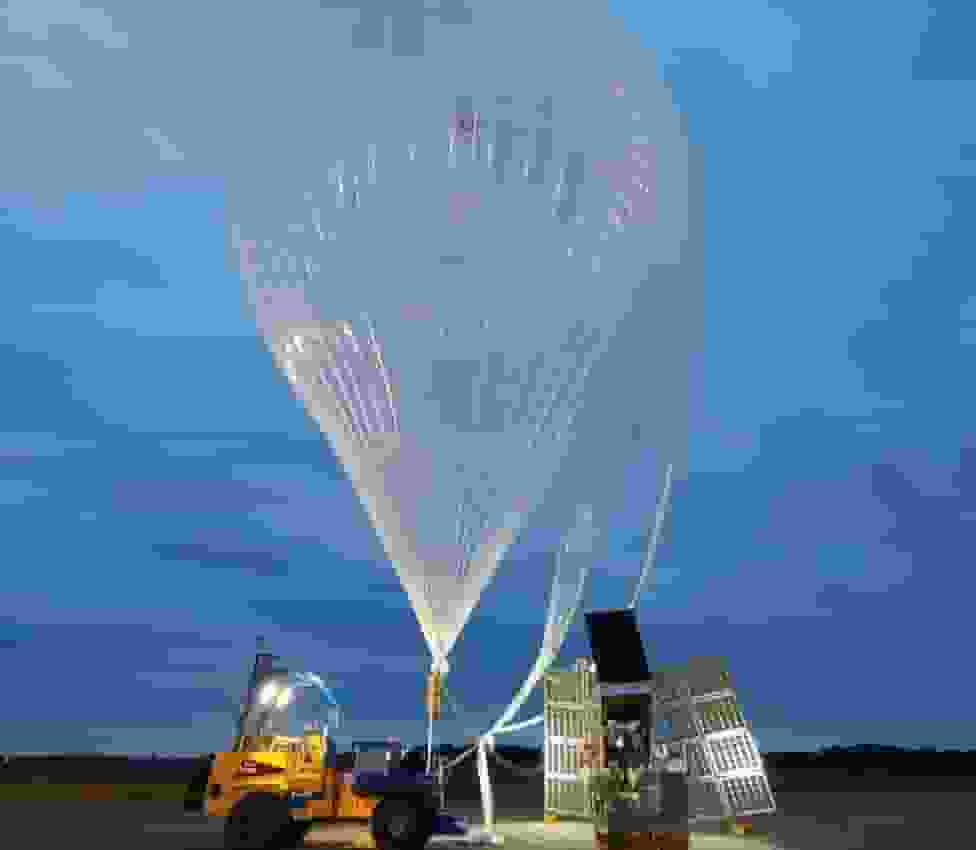NASA’s telescope, which was launched earlier this year on a balloon the size of a football stadium, experienced damage upon landing in Argentina in June and lost contact with Earth.
However, the data it had gathered—200 gigabytes of breathtaking photos of galaxy clusters taken while floating 30,000 meters (100,000 feet) above Earth’s surface—had been copied to vintage SD cards and had safely descended to the ground, demonstrating that priceless scientific data can be recovered even in the “worst-case scenario,” according to a report released by scientists on Tuesday, Nov. 14.
Situated 8.4 billion light-years distant, the cluster, also known as SPT-CL J2215-3537, or simply SPT2215, is observed as it did when the universe, which is currently 13.8 billion years old, was just 5.3 billion years old. Galactic clusters, which are collections of up to hundreds of galaxies with gas, dust, and dark matter braided between them, were prone to frequent collisions and mergers throughout that period of time due to the generally chaotic conditions in the universe.
By identifying the X-rays released by the heated gas within the clusters, one may trace the history of those violent encounters. Scientists have learned from studying those X-rays that, although collisions regularly broke up these clusters, they also helped them develop.
The Super Pressure Balloon Imaging Telescope (SuperBIT), a $10 million balloon-borne observatory, was created to allow astronomers to make portable surveys of celestial objects. The primary objective was to measure how celestial objects bend space and time around galaxy clusters in order to aid in the mapping of dark matter surrounding them.
The Royal Astronomical Society (RAS) made an announcement about the Superpressure Balloon-borne Imaging Telescope (SuperBIT) on Tuesday, July 20. Researchers from Princeton University, the University of Toronto in Canada, Durham University in the United Kingdom, and the Canadian Space Agency collaborated to create it.
According to the team’s assertions, SuperBIT is a new space telescope that might be the next big thing in astronomy. According to Mohamed Shaaban, a doctorate student at the University of Toronto, “new balloon technology makes visiting space cheap, easy, and environmentally friendly,” the statement claimed. On Wednesday, July 21, Shaaban gave a description of SuperBIT during the virtual RAS National Astronomy Meeting (NAM 2021).
In order to get photographs of its galaxy cluster targets in visible to near-ultraviolet light wavelengths, SuperBIT circled the planet around five times after taking launch in April from Wānaka Airport in New Zealand. Among its goals were the Pinwheel spiral galaxy, 60 million light-years away, the two colliding Antennae galaxies, and the star-forming areas of the Tarantula Nebula, 161,000 light-years from Earth.
On May 19, the newly discovered supernova in the Pinwheel Galaxy—also known as Messier 101, or M101—came into view. Under dark sky circumstances, the galaxy may be seen with a small telescope as long as you use a low-power eyepiece and a broad field of view.
The explosion was initially observed by Yamagata, Japan-based supernova hunter Koichi Itagaki. Later on May 20, Zwicky Transient Facility (ZTF) in California telescopes verified the explosion.
Due to “conflicting wind predictions,” SuperBIT’s originally scheduled 100-day mission was cut to 40 days, during which time the telescope returned to the intended landing site, a secluded hill in Argentina. However, due to an equipment malfunction, the parachute failed to detach from its cargo at impact, dragging the telescope over uneven ground for a few kilometers as strong winds passed overhead.
Lead author of the new SuperBIT research, Ellen Sirks of the University of Sydney, stated in a statement, “We lost high-bandwidth communications because our telescope got to the point where it was completely destroyed.”
Typically, a satellite is used to download data collected by balloon-borne telescopes such as SuperBIT; however, rapid downloads need line-of-sight connections, which is not always possible.
“In our case, we were getting so much data per night that it would just be incredibly slow and expensive to retrieve this data mid-flight,” Sirks stated. “At the moment, the most efficient way for us to download data is to copy it onto an SD drive and just drop it to Earth, which is kind of crazy, but it works well.”
In order to communicate with the telescope, she and her colleagues from Australia, the U.K., the U.S., Canada, Europe, and Taiwan created “recovery packages” that included small computers with SD cards for data storage, a homemade satellite link, and parachutes protected in waterproof chicken roasting bags.
The operation in and of itself required helping the local police retrieve SuperBIT’s recovery package from the Argentine countryside, according to experts participating in the expedition.
“We couldn’t find one at first, and when we did, there were cougar tracks in the snow near it, so we thought maybe the chicken roast bag was not the best idea,” replied Sirks. “It was quite funny. But we did retrieve them quite easily.”
While Sirks and her group had been working on this technology for almost five years, this expedition was the first time they tested it in its completed form. Sirks stated that in addition to working, “it was really quite essential to the mission’s success.”
“It’s got to the point where NASA wants to start producing these packages for other science missions as well, so this was really our final test to show that this system works.”




![Tyson Foods Plant [Photo: Food Manufacturing]](https://southarkansassun.com/wp-content/uploads/2023/08/iStock_1185520857__1_.5e441daa51cca-600x337.jpg)








![Silverado Senior Living Management Inc. [Photo: Los Angeles Times]](https://southarkansassun.com/wp-content/uploads/2023/10/download-6-4-600x337.jpg)

![China's Wuhan Institute of Virology [Photo: Nature]](https://southarkansassun.com/wp-content/uploads/2023/09/d41586-021-01529-3_19239608-600x337.jpg)















